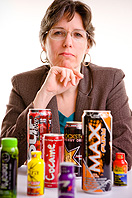News
Energy drinks linked to substance use
-
 Print
Print -
 Comments
(1)
Comments
(1)
-

“No question, we’ve got quite a caffeine habit. But energy drinks bring something more to the equation.”
Frequent use of energy drinks is associated with binge drinking, alcohol-related social problems and misuse of prescription drugs among musicians, according to researchers at UB’s Research Institute on Addictions.
In survey results published in the Journal of Caffeine Research this spring, RIA research scientists Kathleen E. Miller and Brian M. Quigley examined substance use by 226 Western New York professional and amateur musicians ages 18-45. In the sample, 94 percent were caffeine users and 57 percent reported use of energy drinks specifically.
Sixty-eight percent of the musicians surveyed reported heavy binge drinking at least once or twice a year and 74 percent reported experiencing at least one alcohol-related social problem, such as hangovers, arguing with others about their drinking or doing something while drinking that they later regretted. Most of those surveyed also reported recreational drug use, including prescription drugs (23 percent), marijuana (52 percent), psychedelic drugs (25 percent) or cocaine (21 percent).
Musicians who used energy drinks reported significantly more misuse of legal substances than those who did not use energy drinks. For example, 31 percent of energy-drink users misused prescription drugs (compared to 13 percent of nonusers) and 76 percent reported binge drinking (compared to 59 percent of nonusers).
Consistent with previous studies of athletes and college students, this study suggests that the unique relationships between energy-drink consumption and other substance use represent more than merely a repackaging of the U.S. public’s longstanding love affairs with coffee and soft drinks. “No question, we’ve got quite a caffeine habit,” observes Miller, who also holds an appointment as an adjunct research assistant professor in the UB Department of Sociology. “But energy drinks bring something more to the equation.”
Manufacturers of popular energy-drink brands appear to target actual or aspiring musicians as a niche market for their products. Rockstar, the second most popular energy drink in the U.S. today, evokes music in its name, sponsors music tours and features selected artists on its website. Loud Energy Drink or Rock On incorporate music-related logos and concert sponsorships. Pimp Juice and Crunk!!! are energy drink brands owned and marketed by individual rap artists.
With names like Monster, Daredevil and Havoc, edgy energy-drink marketers consistently use brand naming, packaging and advertising messages to tie the products to themes of rebellion, risk taking and even illegal drug use, Miller points out. This may help to explain the unique associations between substance misuse and energy drinks but not other caffeinated beverages, she suggests. It also may give energy drinks a special appeal for musicians, who tend to score high on the personality trait of sensation-seeking.
Given the unconventional lifestyles often associated with paid musicianship—such as late or irregular hours and periodic sleep deprivation—it is likely, Miller says, that professional musicians constitute an especially fertile demographic for energy drinks, which derive their pharmacological impact primarily from caffeine.
Caffeine in low or moderate doses is a common feature of most U.S. diets. However, because they are classed as dietary supplements and therefore not subject to FDA regulation like other caffeine products, energy drinks constitute a greater than average risk for caffeine intoxication, a recognized clinical syndrome associated with higher than average doses. High levels of caffeine use have been linked to adverse health effects ranging from anxiety, irritability and insomnia to high blood pressure, cardiac arrhythmias, seizures and even death, in rare cases.
In the current study, most participants were male (60 percent) and non-Hispanic white (72 percent), with an average age of 28. Approximately one-fourth had a high school diploma or less, one-fourth had attended some college, 22 percent had a bachelor’s or postgraduate degree and the remaining 29 percent were currently in school. Thirty-six percent were employed full time or part time as professional musicians.

Reader Comments
Douglas Morrison says:
I'm glad that grant money is wasted on pointless research.
Posted by Douglas Morrison, Student, 06/26/11